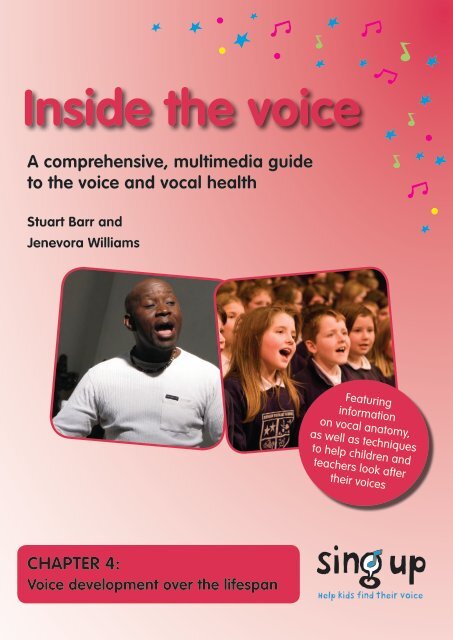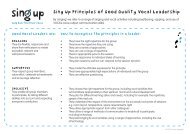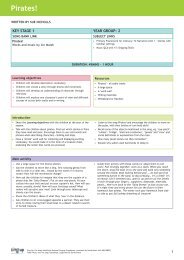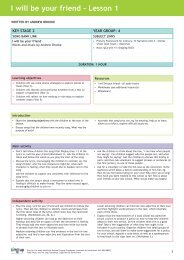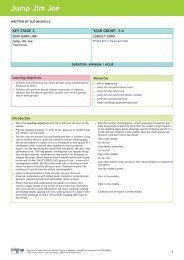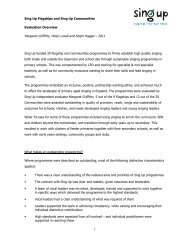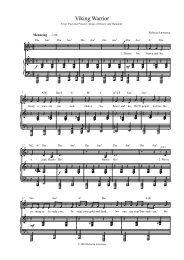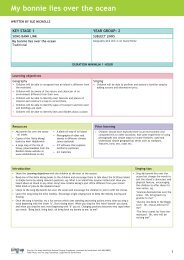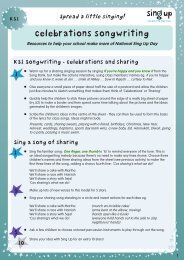Voice development over the lifespan - Sing Up
Voice development over the lifespan - Sing Up
Voice development over the lifespan - Sing Up
Create successful ePaper yourself
Turn your PDF publications into a flip-book with our unique Google optimized e-Paper software.
Song<br />
Ban<br />
More<br />
online<br />
Get in<br />
touch<br />
Song<br />
Ban<br />
Inside <strong>the</strong> voice<br />
More<br />
online<br />
Book<br />
online<br />
Song<br />
Ban<br />
Book<br />
online<br />
Get in<br />
touch<br />
Song<br />
Song<br />
Ban<br />
Ban<br />
A comprehensive, multimedia guide<br />
to <strong>the</strong> voice and vocal health<br />
Stuart Barr and<br />
Jenevora Williams<br />
More<br />
online<br />
Book<br />
online<br />
More<br />
online<br />
Get in<br />
touch<br />
Book<br />
online<br />
Song<br />
Ban<br />
Song<br />
Ban<br />
Song<br />
More<br />
online<br />
Ban<br />
Book<br />
online<br />
Get in<br />
touch<br />
More<br />
online<br />
More<br />
online<br />
More<br />
online<br />
Get in<br />
touch<br />
Book<br />
online<br />
Book<br />
online<br />
Get in<br />
touch<br />
Get in<br />
touch<br />
Featuring<br />
information<br />
on vocal anatomy,<br />
as well as techniques<br />
to help children and<br />
teachers look after<br />
Book<br />
online<br />
Get in<br />
touch<br />
<strong>the</strong>ir voices<br />
CHAPTER 4:<br />
<strong>Voice</strong> <strong>development</strong> <strong>over</strong> <strong>the</strong> <strong>lifespan</strong><br />
INSIDE THE VOICE www.singup.org 1
Welcome<br />
<strong>Sing</strong> <strong>Up</strong> is delighted to present you with Inside <strong>the</strong> voice, an authoritative handbook for <strong>the</strong> spoken and<br />
singing voice. Produced for classroom teachers and o<strong>the</strong>r professional voice users, this accessible and<br />
engaging resource tells you everything you need to know about how your voice works and how you can look<br />
after it. It also gives information about children’s voices, alongside insights into warm-up <strong>the</strong>ory and tips for<br />
improving vocal technique. The content is rigorously backed up by evidence-based research and has been<br />
vetted by an academic panel at <strong>the</strong> top of <strong>the</strong>ir fields.<br />
Each of <strong>the</strong> six chapters are written as standalone documents, meaning you can pick <strong>the</strong> bits that are most<br />
useful to you. If you want to get <strong>the</strong> most of what <strong>the</strong> resource has to offer though, we recommend you<br />
read all six! There is also a handy glossary, where you can find definitions of <strong>the</strong> more technical terms used<br />
elsewhere in <strong>the</strong> resource.<br />
We hope you enjoy Inside <strong>the</strong> voice, and that it gives you and your pupils all you need to keep your<br />
voices healthy.<br />
Contents<br />
1. Vocal health and awareness<br />
2. How <strong>the</strong> voice works<br />
3. <strong>Voice</strong> care in and out of <strong>the</strong> classroom<br />
4. <strong>Voice</strong> <strong>development</strong> <strong>over</strong> <strong>the</strong> <strong>lifespan</strong><br />
5. Improving singing technique<br />
6. Warm-up <strong>the</strong>ory & practice<br />
7. Glossary & fur<strong>the</strong>r reading<br />
The authors<br />
Stuart Barr M.Phil, M.A.(Cantab), PGAdvDip(RCM), HonARAM, is a consultant singing coach and conductor<br />
working with choirs, West End performers and pop artists at <strong>the</strong> highest level. He was President of <strong>the</strong> British<br />
<strong>Voice</strong> Association 2009-2010, is a judge for BBC Choir of <strong>the</strong> Year, and regularly presents on <strong>the</strong> workings of<br />
<strong>the</strong> voice at conferences.<br />
Jenevora Williams PhD ARCM, is a singing teacher and voice researcher. She is singing consultant for <strong>the</strong><br />
National Youth Choir and has taught at <strong>the</strong> Royal College of Music, as well as in universities and at <strong>the</strong> major<br />
UK ca<strong>the</strong>drals. In her busy private practice, she works with people ranging from professionals to students.<br />
She was recently awarded a PhD for research on <strong>the</strong> vocal health and <strong>development</strong> of choristers, and <strong>the</strong><br />
Van Lawrence Prize for her contribution to <strong>the</strong> field of voice research.<br />
Inside <strong>the</strong> voice team<br />
Editor: Henry Bird<br />
Resource team: Celi Barberia, Louise Cleverdon, Beth Millett<br />
Advisory panel: Professor Graham Welch (Chair of Music Education, Institute of Education);<br />
Dr Declan Costello (Consultant Ear Nose & Throat Surgeon, Queen Elizabeth Hospital, Birmingham and<br />
55 Harley Street, London)<br />
Design by: Frances Mat<strong>the</strong>ws; Illustrations by: Harry Venning<br />
© 2011 Stuart Barr and Jenevora Williams<br />
INSIDE THE VOICE www.singup.org<br />
2
Inside <strong>the</strong> voice<br />
Chapter 4: <strong>Voice</strong> <strong>development</strong><br />
<strong>over</strong> <strong>the</strong> <strong>lifespan</strong><br />
In this chapter:<br />
As our bodies grow throughout our lives, our voices change. Understanding<br />
<strong>the</strong> limitations of <strong>the</strong> voice at various stages of its <strong>development</strong> can help us to<br />
choose appropriate exercises and repertoire.<br />
How <strong>the</strong> voice ages throughout <strong>the</strong> <strong>lifespan</strong><br />
An introduction to <strong>the</strong> effects of <strong>the</strong> ageing process on <strong>the</strong> voice<br />
Early voice use - 0-6 years<br />
Find out how an infant’s voice is not just an adult’s in miniature!<br />
Children’s voices - 7-12 years<br />
Learn about <strong>the</strong> gradual improvement in pitch range, strength and stability that takes place<br />
before <strong>the</strong> teenage years<br />
Adolescent voices - 12-18 years<br />
Disc<strong>over</strong> how puberty marks big changes in both boys’ and girls’ voices<br />
Adolescent girls’ voices<br />
Learn about <strong>the</strong> effects of puberty on <strong>the</strong> female voice<br />
Adolescent boys’ voices<br />
Understand how <strong>the</strong> male voice changes through <strong>the</strong> five phases of puberty<br />
Adult and ageing voices<br />
Find out when <strong>the</strong> voice reaches peak form, and how ageing can cause vocal difficulties<br />
4<br />
4<br />
6<br />
7<br />
7<br />
8<br />
10<br />
INSIDE THE VOICE www.singup.org<br />
3
How <strong>the</strong> voice ages throughout <strong>the</strong> <strong>lifespan</strong><br />
2. HOW THE VOICE CHAPTER WORKS 4<br />
<strong>Voice</strong>s age in a similar way to our bodies. Our voices spend <strong>the</strong> first twenty or so years making <strong>the</strong> transition<br />
from birth to adulthood. There is <strong>the</strong>n a slow increase in strength and stamina until our forties or fifties,<br />
before our vocal capabilities are gradually reduced.<br />
Knowing how <strong>the</strong> voice changes throughout <strong>the</strong> <strong>lifespan</strong> enables us to understand both our own and<br />
o<strong>the</strong>rs’ voices. Understanding <strong>the</strong> limitations at each stage can help us choose appropriate repertoire<br />
and exercises. The most important point to appreciate is that <strong>the</strong> child’s voice is not just an adult’s voice in<br />
miniature. As <strong>the</strong> larynx and respiratory muscles develop, <strong>the</strong>y change in both ability and in function (see<br />
Diagram 1).<br />
Early voice use - 0-6 years<br />
The first vocalising a baby does is crying. This contains all <strong>the</strong> elements of singing: pitch contour, varied<br />
rhythmic intensity, loudness and softness, and most importantly, emotional communication. After a few<br />
weeks, <strong>the</strong> child begins to coo and <strong>the</strong>n babble.<br />
Parents instinctively speak to <strong>the</strong>ir babies in a higher pitch range, with extended vowels and a greater<br />
pitch variation. This is known as ‘mo<strong>the</strong>rese’ and contains all <strong>the</strong> musical elements of song. All cultures have<br />
infant-specific songs for both calming and stimulating <strong>the</strong> baby. <strong>Sing</strong>ing is nearly always accompanied by<br />
physical movement, such as rocking or jiggling movements. This intuitive behaviour between adult and child<br />
will develop musical activity as an integral part of <strong>the</strong> child’s environment.<br />
The vocal structure of <strong>the</strong> infant<br />
The baby’s vocal instrument is based on <strong>the</strong> survival requirements for crying and sucking. The infant’s set-up<br />
is much better than <strong>the</strong> adult at:<br />
• z Valving <strong>the</strong> airway: providing extra protection<br />
against foreign bodies entering <strong>the</strong> windpipe.<br />
• z Helping <strong>the</strong> feeding process: <strong>the</strong> close<br />
proximity of parts of <strong>the</strong> pharynx allows both<br />
suckling and breathing to happen simultaneously.<br />
• z Making attention-grabbing noises: <strong>the</strong> child<br />
possesses a potentially life-saving ability to cry<br />
with great stamina! It is tempting to use this as a<br />
model of efficient sound production for <strong>the</strong> adult<br />
voice. However, a baby’s vocal structure has<br />
evolved to be good at producing loud noises in<br />
short bursts <strong>over</strong> a long period of time, with only<br />
limited variation in <strong>the</strong> sounds. To cope with <strong>the</strong><br />
subtleties of communication through language,<br />
<strong>the</strong> voice has to change a great deal.<br />
Diagram 1: Infant versus adult larynx<br />
Infant larynx<br />
(enlarged)<br />
Adult larynx<br />
The infant’s larynx is not just an adult larynx in<br />
miniature. The infant’s needs are those related<br />
to immediate survival, so <strong>the</strong> muscles used for<br />
crying and stopping food entering <strong>the</strong> larynx are<br />
proportionally larger than those in adults’ larynxes.<br />
INSIDE THE VOICE www.singup.org 4
CHAPTER 4<br />
The vocal structure of <strong>the</strong> young child<br />
As infants grow into young children, <strong>the</strong>ir vocal set-up develops, giving <strong>the</strong>ir voices certain qualities and<br />
limitations. Helping <strong>the</strong> <strong>development</strong> of language, <strong>the</strong> larynx moves lower in <strong>the</strong> throat, <strong>the</strong> cartilages<br />
become more firm and mobile, and lung volume increases. This is a gradual process and continues through<br />
puberty and beyond.<br />
Young children’s lungs are still relatively small and do not permit extended sung phrases. The cartilages<br />
are still relatively soft and movement between <strong>the</strong>m lacks control, resulting in a small dynamic range and<br />
making pitch changes more difficult than in adults. Fur<strong>the</strong>rmore, as <strong>the</strong>ir voices get louder, children find it<br />
difficult to maintain a consistent pitch.<br />
Diagram 2: How <strong>the</strong> vocal tract changes shape during childhood<br />
Nasal cavity<br />
Oral cavity<br />
Tongue<br />
Epiglottis<br />
Larynx<br />
Newborn baby<br />
Seven year old<br />
As Diagram 2 shows, a baby’s epiglottis is so high that it can close off <strong>the</strong> oral cavity, allowing <strong>the</strong> baby to<br />
suckle whilst breathing. As <strong>the</strong> child grows up, this ability is lost with <strong>the</strong> growth of <strong>the</strong> tongue and airways.<br />
The length of <strong>the</strong> tube between <strong>the</strong> lips and <strong>the</strong> larynx also grows, changing <strong>the</strong> tube’s characteristic<br />
resonance (or ‘formant’ – see ‘Filter: <strong>the</strong> upper vocal tract’ in Chapter 2 to find out more), giving <strong>the</strong> child’s<br />
voice a different sound quality. This change in sound quality, along with a change in pitch caused by <strong>the</strong><br />
growth of <strong>the</strong> larynx, means that we can often identify <strong>the</strong> age of a child just by <strong>the</strong> sound of his or her voice.<br />
To summarise, <strong>the</strong> young child is less able to sing long, high or loud notes, or make frequent changes<br />
of pitch.<br />
<strong>Sing</strong>ing technique for children aged 2-6<br />
• z Posture: standing whilst singing is <strong>the</strong> best posture, even though <strong>the</strong> children may get fidgety after a<br />
while. If <strong>the</strong>y sit on chairs, encourage <strong>the</strong>m to sit up on <strong>the</strong> front of <strong>the</strong> chair with feet flat on <strong>the</strong> floor. If<br />
you ask <strong>the</strong>m to hold <strong>the</strong>ir heads up, <strong>the</strong>y may well misunderstand and put <strong>the</strong>ir chins into <strong>the</strong> air. This<br />
is a particular problem of sitting on <strong>the</strong> floor. Instead, ask <strong>the</strong>m to imagine being pulled up by a piece of<br />
string attached to <strong>the</strong> crown of <strong>the</strong>ir heads.<br />
• z Movement: a really good way to ensure good body use during singing is to incorporate movement.<br />
Most children’s songs for this age group are action songs. This is helpful for memorisation as well as<br />
effective and balanced body use.<br />
• z Breathing: this will mostly be an instinctive action at this stage. If children are asked to take a big<br />
breath, <strong>the</strong>y may lift and tense <strong>the</strong>ir chest and shoulders, which is contrary to good singing. If <strong>the</strong>y are<br />
standing or sitting well, <strong>the</strong>ir breathing will probably be fine.<br />
INSIDE THE VOICE www.singup.org 5
CHAPTER 4<br />
• z Pitch range and voice timbre: children can be encouraged to explore<br />
and use <strong>the</strong> upper pitch range. This can often help <strong>the</strong>m to sing pitches more<br />
accurately as <strong>the</strong>y move away from <strong>the</strong>ir habitual speaking pitch. It will also<br />
help to make <strong>the</strong>m less shouty. If <strong>the</strong>y find this pitch range difficult to access,<br />
<strong>the</strong>y can find it using comic-strip noises (ie. <strong>the</strong> type of noises children make<br />
when playing with toys) or whooping, wailing or mewing. Descending sighs<br />
and sirening (sliding <strong>the</strong> pitch of your voice up and down, as though on a<br />
rollercoaster track) can also help. The more intuitive <strong>the</strong> noise, <strong>the</strong> more likely<br />
it will be made with low, connected breathing; when we make sounds with<br />
genuine emotion, we tend to use our voices more efficiently.<br />
Children’s voices - 7–12 years<br />
Physical <strong>development</strong><br />
The physical <strong>development</strong> of <strong>the</strong> voice and <strong>the</strong> body during this stage is one of gradual growth before <strong>the</strong><br />
more dramatic changes related to puberty (see ‘Adolescent voices – 12-18 years’ on p7). The lungs gradually<br />
increase in size and <strong>the</strong> larynx lowers slightly. The most noticeable differences are those of coordination and<br />
control. From <strong>the</strong> age of 7 or 8, <strong>the</strong> child becomes able to learn movements and gestures with increasing<br />
levels of complexity and skill. Pitch range, loudness, flexibility and stamina all grow, but are still limited.<br />
<strong>Sing</strong>ing technique<br />
Although it can be taught earlier, this is <strong>the</strong> age when children can most usefully begin to learn effective<br />
breathing technique, related to balanced posture. They can learn to allow <strong>the</strong> belly to move inwards as<br />
<strong>the</strong>y sing and <strong>the</strong>n for it to release outwards as <strong>the</strong>y brea<strong>the</strong> in (see Chapter 5 for tips on helping <strong>the</strong>m<br />
improve this technique). This should always be gentle and flexible; <strong>the</strong>re is no need to ‘hold’ anything.<br />
Children of this age can also learn different voice qualities and choose between <strong>the</strong>m appropriately for<br />
<strong>the</strong> music <strong>the</strong>y are singing.<br />
• z Loudness: partly limited by <strong>the</strong> growing size of <strong>the</strong> larynx and vocal tract. This may be hard to believe if<br />
you are in a school dining room at lunchtime! However, asking children to sing too loudly can encourage<br />
a harsh quality.<br />
• z Stamina: children at this age are unable to sustain loud or high singing to <strong>the</strong> same extent as adults<br />
or <strong>the</strong>ir older peers (a limitation to remember if <strong>the</strong>y are singing repertoire written for adults). They will<br />
have to sing more quietly, occasionally down <strong>the</strong> octave, and have more frequent breaks. If <strong>the</strong>y are<br />
singing solo repertoire written for adult voices, <strong>the</strong>y may need to take more breaths and sing at a slightly<br />
faster tempo.<br />
• z Flexibility: as <strong>the</strong>ir voices<br />
are not as flexible as adult<br />
voices, rapid pitch changes<br />
are not as easy for children at<br />
this age to achieve.<br />
Diagram 3: Range increase in children<br />
(middle C)<br />
• z Pitch: extends downwards<br />
as <strong>the</strong> larynx grows and<br />
<strong>the</strong> speaking voice lowers.<br />
The top of <strong>the</strong> range varies<br />
greatly from child to child.<br />
Some manage to sing C6<br />
and beyond (see Diagram 3). 1<br />
O<strong>the</strong>r children will find it less<br />
comfortable to sing in <strong>the</strong>ir<br />
upper range, which is not<br />
surprising as it requires great<br />
flexibility and practice.<br />
Year 3<br />
Year 4<br />
Year 5<br />
Year 6<br />
C5<br />
<strong>Sing</strong> <strong>Up</strong>’s own research on 10,000 children, carried out by a team led by<br />
Professor Graham Welch from <strong>the</strong> Institute of Education, shows how <strong>the</strong><br />
average comfortable singing range increases throughout this period.<br />
INSIDE THE VOICE www.singup.org 6<br />
C6
CHAPTER 4<br />
Adolescent voices - 12-18 years<br />
Physical <strong>development</strong><br />
Puberty can last from as little as eight months, to as<br />
much as four years. The physical growth happens in<br />
spurts or stages. As <strong>the</strong> child grows noticeably taller,<br />
<strong>the</strong> larynx also grows. However, <strong>the</strong> rate at which<br />
<strong>the</strong> larynx grows is different for boys than it is for<br />
girls: <strong>over</strong> puberty, <strong>the</strong> male larynx grows an average<br />
of 66%, while <strong>the</strong> female larynx only grows at an<br />
average of 33% (see Diagram 4).<br />
Although <strong>the</strong> vocal folds have essentially reached<br />
adult length at <strong>the</strong> end of puberty, <strong>the</strong> connective<br />
tissue of <strong>the</strong> folds continues to increase in size and<br />
quantity into early adulthood.<br />
<strong>Sing</strong>ing technique<br />
Diagram 4: Larynx growth<br />
Female<br />
Male<br />
This shows <strong>the</strong> upper cartilage of a child’s larynx<br />
(solid line) and adult’s larynx (dashed line). Both<br />
boys’ and girls’ larynxes grow during puberty, but<br />
<strong>the</strong> size increase in boys is much greater.<br />
Starting to learn appropriate vocal technique at this age is particularly helpful if adolescent students are to<br />
sing solo repertoire. Although it is possible to sing without technical input, <strong>the</strong> right sort of help will maximise<br />
<strong>the</strong> potential in <strong>the</strong> child’s voice and prevent bad habits occurring.<br />
One problem encountered when working with teenage singers is in allocating <strong>the</strong> traditional soprano,<br />
alto, tenor and bass choral parts. This repertoire has generally been written for adult voices, with ranges and<br />
abilities different from those of teenagers. Whatever <strong>the</strong> solution, it will involve some compromise. A modest<br />
amount of high singing is good, as it will exercise and extend <strong>the</strong> range as it develops. However, singing in<br />
<strong>the</strong> lower registers is often easier for adolescents because it is closer in pitch to <strong>the</strong> spoken voice. Don’t ask<br />
singers to sing too high for too long, especially teenage boys.<br />
Adolescent girls’ voices<br />
Physical <strong>development</strong><br />
Although less so than in boys, girls’ larynxes get slightly bigger during puberty, meaning <strong>the</strong> pitch of<br />
<strong>the</strong>ir voices gets lower. Alongside this, <strong>the</strong>re can be an increase in breathiness or roughness for a period of<br />
time before it stabilises. Women also have a greater tendency to have a small<br />
gap at <strong>the</strong> back of <strong>the</strong> vocal folds, which makes <strong>the</strong> voice slightly breathier. This can be reduced or<br />
eliminated with technical work.<br />
Onset of menstruation<br />
Girls’ voices can be affected by <strong>the</strong> onset of <strong>the</strong> monthly cycle. In <strong>the</strong> few pre-menstrual days and days 1-3,<br />
<strong>the</strong> vocal folds may become slightly swollen. This makes it harder to sing quietly or high without breathiness,<br />
in addition to <strong>the</strong> <strong>over</strong>all instabilities caused by growth. It can take several months after it begins for <strong>the</strong> cycle<br />
to settle into a more predictable pattern. In some girls and women, <strong>the</strong> discomfort and vocal unpredictability<br />
of <strong>the</strong>ir monthly cycle requires <strong>the</strong>m to take a contraceptive pill, and use of <strong>the</strong> more recent low-dosage pill<br />
has been shown to reduce <strong>the</strong> unfavourable symptoms in <strong>the</strong> voice.<br />
INSIDE THE VOICE www.singup.org 7
CHAPTER 4<br />
<strong>Sing</strong>ing technique<br />
• z Breathing: developing and maintaining effective and energised lower-abdominal breathing (see<br />
Chapter 5) is particularly beneficial at this stage. Technical aspects, such as onset and sustain, can be<br />
worked on, as can a variety of musical styles and <strong>the</strong>ir related vocal timbres.<br />
• z Breathiness: can be worked on effectively (see ‘Clear tone’ in Chapter 5).<br />
• z Register breaks: teenage girls often have a strong and well-developed lower range, but a<br />
comparatively weak and breathy upper range. They may try to avoid singing high notes, but <strong>the</strong>re are<br />
many ways in which register breaks can be worked on:<br />
• Lighten off <strong>the</strong> voice in <strong>the</strong> lower range and work on deconstriction (see ‘Avoiding constriction<br />
in <strong>the</strong> larynx’ in Chapter 5).<br />
• Explore upper pitches with clear and energised sounds using non-singing sounds (eg. by<br />
using <strong>the</strong> Siren warm-up from <strong>the</strong> <strong>Sing</strong> up <strong>Voice</strong> Box).<br />
• Blur <strong>the</strong> boundary, bringing <strong>the</strong> upper voice down below <strong>the</strong> pitch of <strong>the</strong> usual register<br />
change, and give <strong>the</strong> singer options of different voice qualities on <strong>the</strong> same pitch. It’s important<br />
for all singers to develop this movable register.<br />
<strong>Sing</strong>ing high notes can be an unfamiliar sensation, as it’s not a regular part of our everyday voice use.<br />
Girls may need to be encouraged to try it out as <strong>the</strong>y might think it sounds horrible! Play with noises and<br />
have fun; <strong>the</strong> laughing pupil will learn more easily than <strong>the</strong> anxious one.<br />
• z Repertoire: <strong>the</strong> repertoire possibilities begin to open out with <strong>the</strong> developing emotional and musical<br />
maturity of <strong>the</strong> singer, although adolescent girls still have limitations of <strong>the</strong> vocal extremes of loud and<br />
high. In general, repertoire written to be sung <strong>over</strong> a large orchestra is not suitable, even when it is sung<br />
with a piano. The phrases are often long and expansive, <strong>the</strong>re are more sustained higher pitches and<br />
<strong>the</strong> vocal timbre is generally fuller. There is much enjoyable repertoire of more modest demands which<br />
encourages <strong>development</strong> of a good, healthy and efficient singing technique.<br />
Adolescent boys’ voices<br />
Physical <strong>development</strong><br />
Male vocal <strong>development</strong> through puberty is best referred to as ‘changing’, as <strong>the</strong> term ‘breaking’ can be<br />
construed as a negative or destructive process.<br />
Boys’ larynxes grow primarily in <strong>the</strong> front-to-back direction, often forming <strong>the</strong> prominent Adam’s apple on<br />
<strong>the</strong> front of <strong>the</strong> neck. Within <strong>the</strong> larynx, <strong>the</strong> vocal folds increase in both length and thickness. This increased<br />
size means that <strong>the</strong>y vibrate at a lower frequency, hence <strong>the</strong> drop in speaking pitch.<br />
Although <strong>the</strong> changes are continual, paediatricians often refer to five phases of puberty, with growth in<br />
physique closely related to <strong>the</strong> voice lowering in pitch (see Diagram 5 on p9). The maximum change in pitch<br />
often occurs at <strong>the</strong> same time as <strong>the</strong> biggest growth spurt, between Phases 3 and 4.<br />
It is more reliable to judge <strong>the</strong> <strong>development</strong>al phase by <strong>the</strong> lower singing range and by <strong>the</strong> average<br />
spoken pitch. The upper pitch range can vary more between individuals.<br />
Assessment<br />
When working with adolescent boys, it’s crucial to assess which phase of vocal <strong>development</strong> <strong>the</strong>y’re in. Invite<br />
<strong>the</strong> child to recite an unexciting list (eg. months of <strong>the</strong> year) and work out where his average speaking note<br />
is on <strong>the</strong> piano. Then look at Diagram 5 to find out which phase he’s in. Remember that <strong>the</strong>se are based on<br />
averages and <strong>the</strong>re will be many individual variations.<br />
Occasionally you may come across a boy whose lowest singing note is not a third below his speaking<br />
pitch. This may be because he is artificially lowering his speaking voice in order to sound older (which is<br />
common in late developers). Alternatively, he might be holding his speaking voice up through trying to<br />
preserve a high singing voice. Any pushing down or holding up of <strong>the</strong> speaking pitch will result in vocal<br />
tension and is best discouraged.<br />
INSIDE THE VOICE www.singup.org 8
CHAPTER 4<br />
Diagram 5: Phases of boys’ voice change<br />
<br />
<br />
Maximum sung range<br />
Easiest sung range<br />
Spoken pitch<br />
<br />
<br />
<br />
<br />
<br />
<br />
<br />
<br />
<br />
<br />
<br />
<br />
<br />
<br />
<br />
Unchanged Phase 1 Phase 2 Phase 3 Phase 4 Phase 5<br />
<br />
Boys’ voices gradually lower as <strong>the</strong>ir larynxes grow during puberty. The above pitch range averages are without<br />
use of falsetto or observable sign of strain and are based upon research by Cooksey and Welch. 2 Whilst<br />
boundaries and <strong>the</strong> speed of change vary between individuals, <strong>the</strong> general pattern is universal. As <strong>the</strong> voice<br />
lowers, <strong>the</strong> usable range contracts before expanding again into manhood.<br />
Range<br />
The key strategy for adolescent boys’ voices is for <strong>the</strong>m to follow <strong>the</strong>ir voice change downwards. Letting <strong>the</strong>m<br />
sing occasionally in falsetto is not going to be a problem (and can help with vocal agility), but for <strong>the</strong> most<br />
part <strong>the</strong>y should sing within <strong>the</strong>ir current comfort zone.<br />
If <strong>the</strong> boy is in <strong>the</strong> early phases (Phases 1 and 2), <strong>the</strong>n singing in <strong>the</strong> soprano range is still fine as long as<br />
it’s comfortable. However, once he enters Phase 3 he will be less able to sing <strong>the</strong> higher pitches. Occasional<br />
use of falsetto pitches, particularly in warm-ups, is fine as it can encourage flexibility in <strong>the</strong> upper ranges.<br />
What is crucial is that most of <strong>the</strong> singing is within <strong>the</strong> fundamental comfort zone, ie. at <strong>the</strong> lower end of <strong>the</strong><br />
pitch range.<br />
Most boys are thrilled by <strong>the</strong> prospect of developing an adult voice. Guard against making <strong>the</strong>m feel bad<br />
about it; any display of disappointment at <strong>the</strong> loss of <strong>the</strong> ability to sing higher pitches can be unhelpful in <strong>the</strong><br />
long term.<br />
<strong>Sing</strong>ing technique<br />
At this stage, <strong>the</strong> voice not only has limitations of range of movement but also ease of movement. As <strong>the</strong><br />
voice lowers, <strong>the</strong>re may be a temporary reduction in dynamic range and a loss of agility. The singer may<br />
also only be able to sustain shorter phrases.<br />
• z Breathing: as with girls, working on developing and maintaining effective and energised lowerabdominal<br />
breathing (see Chapter 5) is particularly beneficial at this stage. Technical aspects such as<br />
onset and sustain can be worked on, as can a variety of musical styles and <strong>the</strong>ir related vocal timbres.<br />
• z Posture: this may be an issue, as boys are often growing rapidly at this stage. Many boys develop<br />
a bad habit of pushing <strong>the</strong> head forward, especially if <strong>the</strong>y are trying to reach high notes. This is to be<br />
avoided, as good posture is critical for future voice <strong>development</strong>.<br />
INSIDE THE VOICE www.singup.org 9
CHAPTER 4<br />
Repertoire<br />
Adolescent boys need to be guided carefully into <strong>the</strong> right repertoire, and finding appropriate solo repertoire<br />
can be a challenge. While most boys will have a usable range of about an octave, some may have as<br />
little as a sixth. Pick songs that have a small range, and change <strong>the</strong> key of <strong>the</strong> music (also known as<br />
‘transposing’) to suit <strong>the</strong> range of <strong>the</strong> boy’s voice. Many pianists can transpose on <strong>the</strong> spot, and electric<br />
keyboards normally have a transpose function. You can also use <strong>the</strong> Scorch song sheets to transpose songs<br />
from <strong>the</strong> Song Bank.<br />
Whatever <strong>the</strong> repertoire, it’s important to encourage adolescent boys to put energy and passion into <strong>the</strong>ir<br />
singing. They tend to enjoy exploiting <strong>the</strong>ir new-found manly tones by singing dramatic and epic songs,<br />
whe<strong>the</strong>r pop, musical <strong>the</strong>atre or classical. However, remember that frequent, high-impact vocalising may<br />
damage <strong>the</strong>ir voices.<br />
Adult and ageing voices<br />
As <strong>the</strong> voice matures in <strong>the</strong> years after puberty, it gains in pitch range, stability, richness, agility, sustainability<br />
and dynamic range. This process may take several years, with adult voices not normally settling down until<br />
<strong>the</strong> mid-twenties. There <strong>the</strong>n follows a golden period of several decades in which <strong>the</strong> voice, if looked after<br />
well, will continue to streng<strong>the</strong>n and increase in stamina.<br />
The age at which <strong>the</strong> voice starts displaying audible signs of ageing varies from person to person. Some<br />
well-known singers are still at <strong>the</strong> peak of <strong>the</strong>ir form in <strong>the</strong>ir late sixties, but for o<strong>the</strong>rs <strong>the</strong> decline starts<br />
happening much earlier.<br />
As we get older, <strong>the</strong>re are three ways that changes in our vocal structure lead to decline in our<br />
vocal ability:<br />
• z Reduced mobility and flexibility of <strong>the</strong> larynx can reduce pitch and dynamic range, hinder pitch<br />
stability and make it harder to make rapid pitch changes.<br />
• z Bowing of <strong>the</strong> vocal folds can make it difficult to voice as efficiently.<br />
• z Loss of muscle tone in <strong>the</strong> larynx and respiratory system causes instability, as well as a loss of control<br />
and sustainability. It can also be <strong>the</strong> source of a very wide vibrato.<br />
The ageing process in <strong>the</strong> voice is tied up with <strong>the</strong> ageing processes of <strong>the</strong> rest of <strong>the</strong> body. While it’s<br />
impossible to stop <strong>the</strong> biological clock, keeping yourself fit and eating a healthy diet are two of <strong>the</strong> few<br />
proven ways to keep what you’ve got, for as long as possible. ‘Use it or lose it’ applies to singing; if you keep<br />
singing regularly, your voice will be slower to succumb to <strong>the</strong> effects of ageing.<br />
In women, <strong>the</strong> menopause can cause additional problems with <strong>the</strong> voice. The symptoms may be similar<br />
to pre-menstrual ones, but <strong>the</strong>re can also be dryness in <strong>the</strong> larynx. Sometimes <strong>the</strong> upper pitch range is also<br />
reduced, and <strong>the</strong> whole system becomes less flexible.<br />
Summary<br />
•z The infant larynx has a very different function to that of a child or an adult.<br />
•z Larynxes grow throughout childhood, in line with <strong>the</strong> rest of <strong>the</strong> body.<br />
•z During puberty <strong>the</strong> larynx grows much more in boys than in girls.<br />
•z The <strong>development</strong> of <strong>the</strong> male voice during puberty is divided into five phases. Boys’ voice ‘change’ is a<br />
preferred term to voice ‘break’.<br />
•z In late middle-age, <strong>the</strong> voice starts to age alongside <strong>the</strong> body’s <strong>over</strong>all ageing processes. Staying fit<br />
and healthy is <strong>the</strong> best way to keep <strong>the</strong> voice in shape as it ages.<br />
•z It’s essential to choose repertoire and exercises that are appropriate for <strong>the</strong> singer’s stage<br />
of <strong>development</strong>.<br />
INSIDE THE VOICE www.singup.org 10
CHAPTER 4<br />
1. Welch, G.F., Himonides, E., Saunders, J., Papageorgi, I., Preti, C., Rinta, T., Vraka, M., Stephens Himonides, C., Stewart, C., Lanipekun,<br />
J., & Hill, J. (2010). Researching <strong>the</strong> impact of <strong>the</strong> National <strong>Sing</strong>ing Programme ‘<strong>Sing</strong> <strong>Up</strong>’ in England: Main findings from <strong>the</strong> first three<br />
years (2007-2010). Children’s singing <strong>development</strong>, self-concept and sense of social inclusion. Institute of Education, University of<br />
London.<br />
2. Welch, G.F. (2006). <strong>Sing</strong>ing and Vocal Development. In G. McPherson (Ed.), The Child as Musician: a handbook of musical<br />
<strong>development</strong>. (pp. 311-329). New York: Oxford University Press.<br />
Cooksey, J. (2000). <strong>Voice</strong> transformation in male adolescents. In L. Thurman, & G. F. Welch (Eds.), Bodymind and <strong>Voice</strong>: Foundations of<br />
<strong>Voice</strong> Education. Revised Edition (pp. 718-738). Iowa City, Iowa: National Center for <strong>Voice</strong> and Speech.<br />
INSIDE THE VOICE www.singup.org 11


